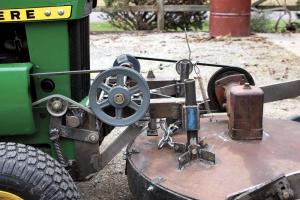2015 - Volume #39, Issue #5, Page #11
[ Sample Stories From This Issue | List of All Stories In This Issue | Print this story
| Read this issue]
Front-Mount Garden Tractor Rotary Mower
 |
 |
 |
“We were using line trimmers and chain saws to clear paths in the woods behind my dad’s house,” recalls Prinkey. “I used to play on them, and now I have grandchildren who play there. My dad said, ‘Why not build a mower?’”
Prinkey’s dad, a former Deere dealer, recalled the Gravely walk-behind as a tough machine. Prinkey found one on Craigslist, looked it over and took measurements.
“I checked it against my 110 Deere garden tractor and other than moving the gearbox, decided it would work,” says Prinkey.
He designed a mounting bracket with a pulley drive that uses the 110’s drive for its belly mower. The pulley driveshaft transfers power from the tractor’s right side to the left to line up with the Gravely. It rides in pillow box bearings attached to two 2 by 2-in. angle iron arms extending forward from the tractor. Crossbars made from 3-in. wide 3/8-in. steel strap, reinforce the arms, which carry the weight and torque of the deck.
The mower’s gearbox, which had connected by a pivot to the Gravely, was shifted 90 degrees to line up with the drive pulley. Without the pivot, Prinkey had to fabricate a way for the rotary deck to float over uneven ground.
He welded 2 sets of tabs to the deck of the mower directly beneath square tubes welded to the ends of the bracket arms, later reinforcing them with added tabs. Steel pipes, with one end bolted to the tabs and the other extending through the square tubing, provide both vertical movement and horizontal pivot for the deck. Holes drilled through the upper end of the pipe provide multiple up-stops, preventing the deck from rising too much, while chains attached between the deck tabs and the cross bars provide down-stops, preventing the deck from dropping too far.
The entire bracket/mower design is heavily reinforced. Arms extending out and forward from the sides of the deck are mounts for dolly wheels. At the rear of the arms, Prinkey mounted smaller rounded wheels that can be adjusted for 3 cutting heights.
“They’re gauge wheels and allow the rear of the deck to go up and over things,” he says. “Because they are rounded, I can make turns without them digging into the ground.
“Figuring out the pulley sizes was the toughest challenge,” says Prinkey. “I needed to get the tip speed right.”
With the help of a Gravely owners manual, Prinkey found out that the Gravely motor and the 110’s pto speeds were similar. The biggest restriction was the belt drive. It needed to remain tight while flexing with the terrain. With the help of the up and down stops that limit deck movement, an idler pulley attached to the deck by a spring does the job.
Prinkey mounted protective guards over the pulleys and belts, as well a front brush guard. With fresh coats of JD yellow and black, the rotary add-on looks factory-made.
“I have 3 cutting positions,” says Prinkey. “I can change the up-stops to match the cutting heights to let me extend the mower out over a creek bank if needed,” says Prinkey. “If I hit an ant hill or other obstacle, the rear arms let the deck pivot to slide up and down. With the front guard, I’ve knocked over 1 1/4-in. dia. trees. The mower makes quick work of the paths.”
Contact: FARM SHOW Followup, R.W Prinkey, 27777 Newton Perkins Rd., West Mansfield, Ohio 43358 (ph 937 355-8302; barebonesgarage@embarqmail.com).

Click here to download page story appeared in.

Click here to read entire issue




